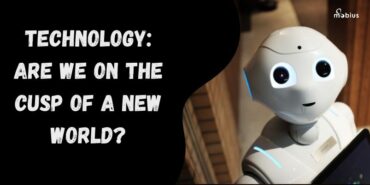What is Augmented Reality?
Do you know what connects people? Emotion. With evolving technology, brands worldwide strive to strengthen the emotion between the brand and people. And augmented reality is one such technology that helps stimulate these emotions near-naturally, awakening the audio-visual senses along with the motion.
Augmented reality offers an interactive experience that superimposes information into a real-life environment. And this reality has found its use in not just the entertainment space. Beyond the holograms that you see in Marvel movies, this is a reality in many other futuristic business use cases.
How does Augmented Reality work?
While each AR experience is unique, the fundamentals behind the working of augmented reality leverage specialized software, apps, and hardware to give us the superimposed image and immersive experience to the physical world.
Basically, using a hardware device such as a smart camera, which is loaded with AR software, captures the environment and object where it identifies the position, geometry, and orientation of the object. The physical environment and specific objects in the real world are captured and parsed by AR software to create a digital replica of things. Then it displays real-time objects that the user can interact with. The physical and the virtual world are connected to each other to bring an immersive feel in real time.
There are broadly two types. One is marker-based AR, where a prior input of the object or environment is preprogrammed to help AR recognize the object. The preprogrammed data acts as a reference to compare the object with the marker. While in markerless AR, you don’t need preprogrammed input of the environment or objects to compare. It recognizes the environment from the point of the scene.
Difference between AR and VR
The main difference between AR and VR is that Augmented reality makes use of a real physical environment and settings, while VR renders a completely virtual environment and does not have any control over the physical environment. To put it in easy words, VR shuts you from the real world and immerses you in a digital environment.
The world of Metaverse: The latest in AR
It all started with Facebook renaming its parent brand to Meta from the term metaverse, indicating what they intend to build. This was the statement made by Mark Zuckerberg when they announced their rebranding:
“We’ve gone from desktop to web to mobile; from text to photos to video. But this isn’t the end of the line. The next platform will be even more immersive — an embodied internet where you’re in the experience, not just looking at it. We call this the metaverse, and it will touch every product we build.” He also said that they would spend millions on building the metaverse platform.
Metaverse is considered to be the next version of the internet, which is a concept of a virtual world to provide a decentralized experience. It creates a new experience void of physical space and objects through augmented and virtual reality.
So if you ask if this thing is new? I’d say No.
It’s been there here for a while in different primitive forms.
From the Instagram filter to a 3D game you play, you’ve probably seen it already. There are games that let your character put on the dress that you want, try the hairstyle that you like, or kill the pigs with the angry bird. Well, these are fictional scenarios that you could do virtually and are aware of them. But what if you could also do more?
What if you could go shopping possibly without getting out of your bed? No, I’m not talking about online shopping. I’m talking about you going to a virtual shop and being able to try those clothes on and purchase them— all virtually! This is a universe where the virtual world aims to coexist with the physical world and lets you live and interact digitally.
Use cases of Augmented Reality
With the advancement in technology and the proliferation of the internet, Augmented reality has found its place in many industries. The immersive technology of AR has become a game-changer in increasing productivity, improving the user experience, and streamlining workflows and has paved the way to developing solutions to various business needs. Here are a few business use cases where augmented reality is used widely:
Retail
Ever wondered how that beautiful long frock looks on you when you hit the dance floor? Amazon has a patent for an AR mirror that lets you try on a virtual version of the dress. Retail space is something many companies are trying to test the water to conquer customers with a unique experience.
Manufacturing
Manufacturing is one industry where the role of AR has been very trivial. Since this industry is highly capital and labor-intensive, harnessing AR has become a game changer in industrial automation. Right from asset identification to detecting faulty components and developing advanced real-time models, AR has improved operations and has reduced manual interventions for risky situations.
Design
IKEA makes use of an augmented reality app called IKEA place to visualize furniture in your space. It lets you place your furniture virtually in your room to find the most suitable place.
Health Care
From detecting veins in the body to visualizing surgical parts, AR has found its use in several techniques in healthcare. Though it is in the early stage, the future of AR is expected to bring significant advancements in the healthcare system.
Entertainment
The idea of escaping reality has been the core of the growth of every new-age gaming industry. We know how much Pokémon made it to the news in 2016 as one of the best of AR at its time. Use cases like this in the entertainment industry will take AR to the next level to expand the technology to other applications.
Final Thoughts
It is estimated that by 2028, the market size of AR is expected to grow to about $90.8 billion. The tremendous potential of augmented reality to solve various problems across industries make it necessary to couple it with the right technology and tools to make it useful to mankind.
When we talk about any innovation in technology, it comes with its own share of demerits. The impact of the change that it makes hits everyone differently. Augmented reality has the ability to change how the generations to come live and interact with each other. So, if everyone is running behind this world, what implications should we be worried about?
For an immersive technology like this, where do we draw the line of safety is important to regulate the technology. It demands the question of how much this experience could turn creepy, given privacy and safety concerns.
Before they become the norm in the near future, understanding the impact of proper policing and regulation in various fields could make this technology worthwhile.






